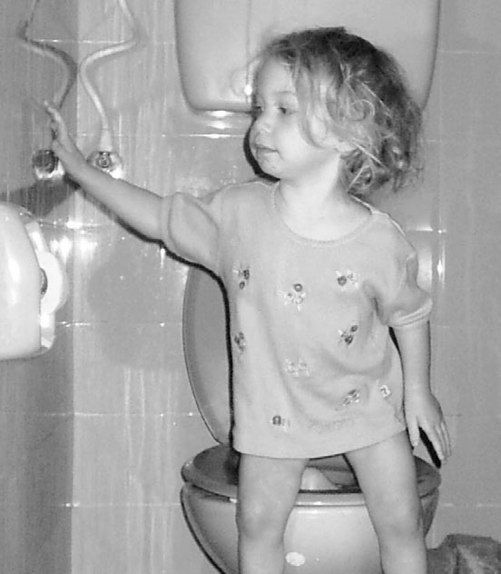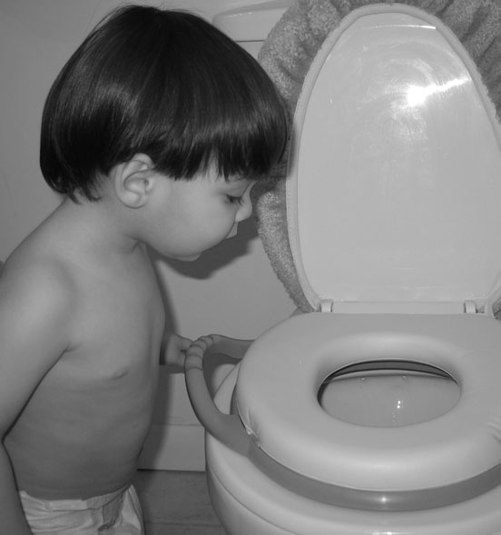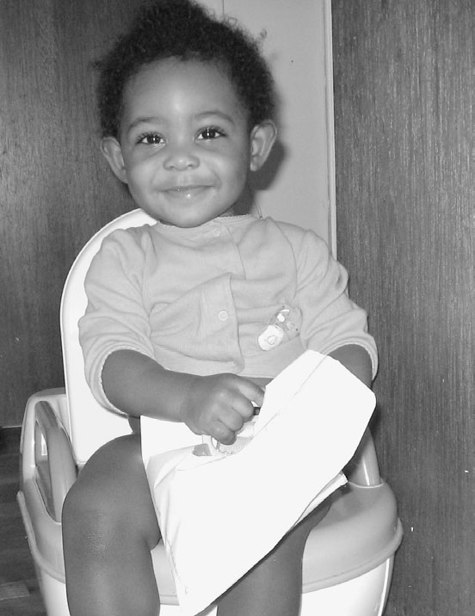The No-cry Potty Training Solution (17 page)
Read The No-cry Potty Training Solution Online
Authors: Elizabeth Pantley

• If your child is showing signs of needing to poop but is not having success on the toilet, try having him lean forward and rest his upper body against you while you gently rub his lower back. You can also have him sit backward on the toilet and lean against the tank.
• Read books about using the potty, especially those that talk about poop (yes, really!) such as these:
Everyone Poops
(My Body Science)
by Taro Gomi, translated by Amanda Mayer
Stinchecum
Kane/Miller Book Publishers; 1st American edi-
tion, 1993
Where’s the Poop?
by Julie Markes and Susan Kathleen Hartung
HarperFestival; Liftflap edition, 2004
The Truth About Poop
by Susan E. Goodman, illustrated by Elwood
Smith
Viking Juvenile, 2004
(This one is aimed at older children but has lots of tidbits that you can pick out to share with your younger child; it’s funny and informative, too.) Setbacks and Regressing
About 80 percent of parents report having to deal with toilet training setbacks, which means you are in very good company! There are about a million reasons that children who are having great success with toilet train-118
The No-Cry Potty Training Solution
ing suddenly go totally backward. Here are a few of the more common reasons for setbacks:
• There is a change in the family or a disruption in the home, such as moving, a new baby, divorce,
marriage, vacation, houseguests, or the holidays.
• The child is bored with the toilet training routine.
• An illness or injury of the child or parent interferes with the usual daily routine for days or weeks.
• There has been a drastic change in routine, such as starting day care, a sibling going off to school, or an at-home parent going off to work.
• The child has mastered toilet training but then has a number of accidents that erode confidence. Perhaps a particularly embarrassing public episode occurs, or the unthinking comments of a family
member or stranger made your child feel inade-
quate. She may have decided it would be safer if she went back to diapers.
• Your child may have been successful at potty training because you were very successful at reminding him to go at the right times. After a period of success you stopped reminding him, and so accidents began to happen.
Setbacks are always temporary; otherwise, we’d see second graders wearing diapers. So when a setback occurs with your child, simply set yourself back, right along with your child, and repeat the actions that were successful for you in the past. For example, if her potty poster was a hit, make a new one. If she was doing perfectly on her potty chair, but a setback occurred soon

Solving Common Toilet Training Problems
119
Sapir, two and a half years old
after the switch to the big toilet, go back to using the little potty. If she responded to two-hour potty reminders, begin setting a timer to remind her to visit the bathroom.
Tuck away your own injured pride, because this has nothing to do with your job as a teacher nor does it mean your child has failed Potty Training 101. It just 120
The No-Cry Potty Training Solution
means your child is normal. Be patient, be supportive, and soon your little one will be back to potty success.
When to Call the Doctor
You should contact your health provider anytime you have concerns about your child’s health. The following are some of the signs that would warrant a phone call:
• Your child hasn’t had a bowel movement in four or more days.
• There is blood in your child’s urine or stool.
• Your child has a fever, is nauseous, or is vomiting.
• Your child isn’t urinating every two or three hours.
• Your child has difficulty starting a stream of urine, even when she has to pee.
• Your child’s urine has a foul smell.
• Your child’s stomach is extended, hard, or swollen.
• Your child’s underwear is frequently smeared with stool, and it’s unrelated to poor wiping habits.
• Your child is potty trained but suddenly regresses for no apparent reason.
• You are getting excessively angry over the situation. Toilet training problems can be very frustrating and are one of the major causes of child abuse. If you’re finding this too much to handle, call a trusted friend or a health care professional.
If your child is having difficulty using the bathroom, or if toilet training has become a major issue in your household, your doctor can help you. She may analyze the progress of toilet training, provide you with advice
Solving Common Toilet Training Problems
121
about diet changes, or put your child on a fiber supple-ment, stool softener, or mild laxative, if necessary.
Any child, no matter how healthy, smart, or capable, can have toilet training problems. Any parent, no matter how wise or experienced, can need help solving these problems. Don’t be shy or embarrassed about seeing a professional about problems with toilet training.
This is very common, and professionals talk with parents every single day on this topic.
This page intentionally left blank
8
Common Questions and
Sensible Answers
Once you enter this new phase in your child’s life you’ll be faced with unique challenges, many of which you’d never have thought of before you began the potty training process. You’ll start to see all things bathroom in a new light and realize that even when you feel fully prepared for everything, an interesting new dilemma will appear. Everyday things like flushing noises, public restrooms, and potty words will require creative problem solving. In this chapter I’ll cover the most common situations and provide information and solutions to help you keep your child moving toward toileting independence.
Fear of Flushing
My son is afraid of the flushing of the toilet. How can I help
him to get over this fear?
It’s not unusual for a child to peer into the toilet and watch the water swirl down the hole to the sound of the loud flush and become confused or fearful about the noise, the hole, or the unknown. Children get past this 123

124
The No-Cry Potty Training Solution
Matthew, seventeen months old
fear in time, but there are a number of ways to help your child overcome his apprehension.
• For a while, wait until he leaves the room and then flush for him. After a few days or a week, casually flush while in the middle of talking,
singing, or playing. Don’t make it a big deal.
• Chat about what happens when the toilet flushes.
Get a book or two from the library about plumb-
Common Questions and Sensible Answers
125
ing, or visit a plumbing fixture showroom and do some exploring. (Just watch him carefully so he doesn’t use a model toilet!)
• Play a game: stand a foot or so from the toilet, take turns tossing Cheerios or Froot Loops into the toilet, and then flush and watch them swirl away.
• Get a copy of the book
It’s Potty Time
(Smart Kids Publishing, 2000). It has a potty training story along with a flushing button that generates lifelike sounds along with children’s giggles.
Coordinating Two Homes for Training
Our daughter spends half her time at my house and half her
time at her father’s. How should we approach toilet training
to make it less confusing for her?
The more consistent things are in both places, the easier this will be for your little one. If possible, it’s great if you could both read the same book or article about toilet training. Decide on an approach and jot down the important points.
Buy two identical potty chairs and keep them in the same place in both homes, such as next to the adult toilet. Purchase duplicate sets of training pants or underwear to be kept at both homes. If you are going to use a chart or potty book, have two of the same, and if you reward with prizes, stickers, or treats, do so at both places.
Of course, there are times when two parents do not communicate or agree on issues such as this. In that case be certain that the experience is pleasant and consistent in your home, and be patient. Children are 126
The No-Cry Potty Training Solution
remarkably resilient, and your child will master toilet training even if both situations aren’t perfectly aligned.
Traveling with a Newly Trained Child
We finally finished toilet training, and our three-year-old is
just now becoming independent. Wouldn’t you know it—
we have to go out of town for a few days for a family wedding. We’ll be driving for six hours and spending a few nights
at a relative’s home. I’m so afraid our little one will forget
everything!
Potty training or no potty training, life must go on!
Families are busy. You could never take a whole year off from life, waiting until your child was a master at independent toileting. So first and foremost, take the focus off of the whole potty training issue and enjoy the occasion. Life is far too short not to take joy when it’s offered to us, and no matter what, your child will eventually be fully trained and you’ll be facing the next adventure in parenting.
Here are a few tips that can help you on your travels:
• Remember that children need to go potty every two hours or so. Plan plenty of stops on your drive for using the bathroom and stretching those little legs.
• If your child uses a potty chair, bring it along with you. It can be used in the car, on the side of the road, at an unfamiliar rest stop, and at your relative’s home once you arrive.
• Keep several complete changes of clothing with you in the car in case of accidents.
Common Questions and Sensible Answers
127
• Cover the car seat with a specially made plastic car seat cover or any protective fabric.
• Maintain as much of your child’s normal potty routine as possible: when he goes, where he goes, and how he goes (do you read, sing, talk?).
• Make sure that your child has plenty of fluids and eats a normal amount of fibrous foods (fruit, vegetables, whole grains) to prevent constipation.
• Practice using new bathrooms before you leave—
at a neighbor’s or friend’s house, a restaurant, or a store—so your child knows that he can use all different kinds of toilets.
• Whenever your child says he has to go potty, take him immediately. Politely excuse yourself and your child and whisk him away. Making him wait when
he announces the need can either cause an acci-
dent or performance anxiety that could stay with him long after your trip.
• Accompany your child on every bathroom visit, because you’ll never know what bathrooms are
child-safe.
Fathers and Daughters in Public
Restrooms
When my husband is out shopping or at a restaurant with
our daughter and she has to go potty, what should he do?
She’s much too young to go into the bathroom alone, and
there’s no way she can hold it until they get home. I certainly
don’t want to prevent them from going out together, so
what’s the solution?

